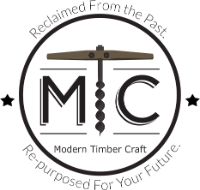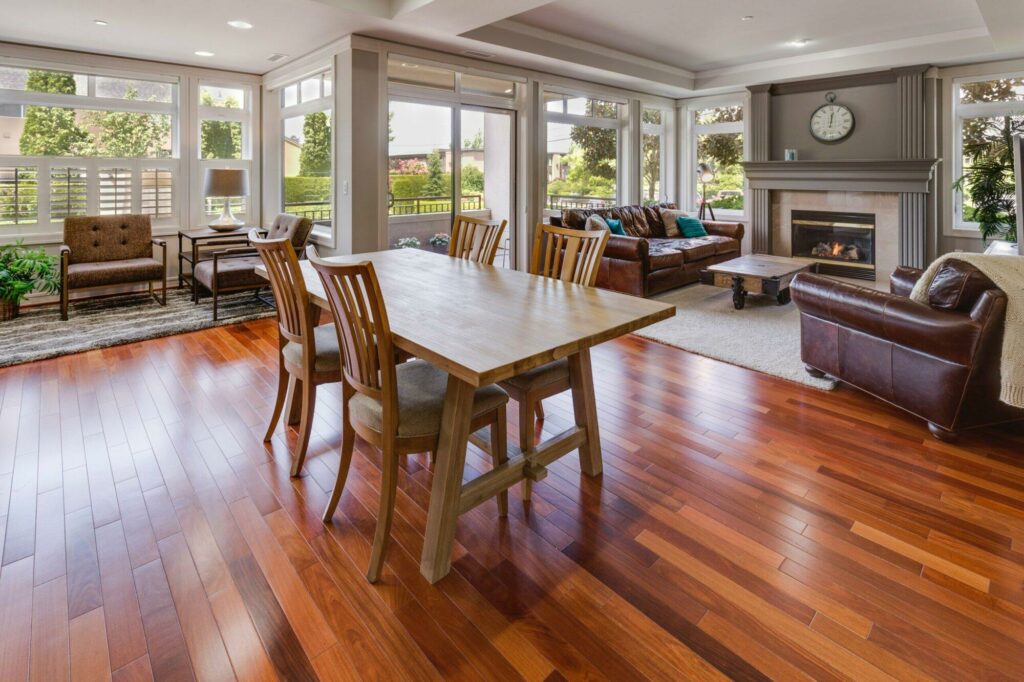Reclaimed (salvaged) wood flooring is an excellent option that repurposes wood from sources such as historic barns, public houses, or factories. Although the use of reclaimed wood flooring is nothing new, it’s rise in popularity has been a recent trend.
We believe reclaimed wood flooring is always a smart decision in home construction or remodeling today. But there are many factors to consider when selecting the right material for your needs. With various aesthetics, durability ratings, textures, price ranges, and so on, it can help to read a guide to help you make informed decisions when choosing the best flooring for your next project.
So let’s take a look at reclaimed wood as an option for your flooring needs.
Why is Reclaimed Flooring Popular?
Why has antique wood reclaimed from old structures gained such popularity? Well, despite the fact that reclaimed flooring can be somewhat expensive, people really like the look of the wood. But it’s more than that: they tend to get attached to the idea of having a part of history in their homes.
When it comes to aesthetics, reclaimed wood flooring has many traits that are not replicable or even found in new wood. Distinct grain patterns, deep rich colors, knots, tool markings, and unique patinas can be found in many floor boards.

Reclaimed wood flooring also has sturdy durability from an extremely low moisture content, thanks to years of air-drying. This improved durability reduces the chances of bending or warping, extending the life and enjoyment of your floors.
Beyond appearances and durability, using reclaimed wood extends the lifecycle of the wood, which may be sourced from buildings 100+ years in age. When you use salvaged wood, the old life lives on in the new. Finally, choosing reclaimed wood flooring reduces the environmental impacts, such as deforestation, attached to using new wood materials. And you reduce the volume of wood material going into landfills when structures are taken down.
What Should you Look for in Reclaimed Wood Flooring?
So, you've decided to go with salvaged wood for your next flooring project. What do you look for? Personal choice, in terms of aesthetics, will be a big factor. But there are a few key factors to consider when selecting your wood flooring.
Location, Location, Location
Where you will apply the flooring impacts the wood species you'll select. For example, when it comes to high traffic areas, a durable species such as oak, walnut, or maple should be used to avoid premature wear or damage to your floors. The Janka Hardness Scale is a helpful indicator of species’ durability.
Finished or Unfinished
Surface texture should also a deciding factor, as texture varies among species. Ultimately, your surface texture will be determined by either finishing your reclaimed wood to achieve a smooth surface or by leaving it unfinished for a more “authentic” texture.
Room “Fit”
Your space should also shape your choice of wood. You want to complement or accent the overall aesthetic in a space with your flooring. From grain to patina, from color to finish, your flooring must fit existing décor, furnishings, wall colors, etc.
Water Resistance
The grain of your wood is not only a factor for appearance and texture, it also helps determine the best use-case for the wood. Tighter “closed” grains increase resistance to water damage and rot.
Most Popular Reclaimed Flooring Options
In terms of popularity, people select many varieties of wood species. Here are the top five used in the United States:
White Oak
This hardwood option is widely available and often used in flooring projects. With a refined closed grain that produces a uniform, straight look, white oak can be easily incorporated into a multitude of spaces and room designs. Its closed grain makes it resistant to water damage and allows it to be used both outdoors and indoors. The color often consists of a mix of light browns and tan shades.
Red Oak
Readily available and often cheaper than a white oak variety, red oak’s popularity has soared in recent years. This variety gives you a more varied look (than white oak) with an open grain that is often wavy in appearance. As for color, red oak consists of red and pinkish tones over tan hues. Red oak’s hardness makes it a fine choice for both indoor and outdoor projects.

close up of reclaimed red oak flooring
Hickory
Hickory is the hardest of the most popular flooring species, offering an option that resists straining and deformation unlike any other. With contrasting colors found along the grain, hickory’s aesthetic appeal can be a standout feature on its own. But it also features a coarse and straight, “open” grain appropriate for many indoor applications.
Douglas Fir
Douglas fir possesses one of the best strength-to-weight ratios when compared to other flooring options. Though it rates low on the Janka scale, Douglas fir is lightweight with a strong closed grain. It is often smoother in texture than other options and can resist water damage.
Maple
This popular hardwood option consists of a typically smooth, straight grain, giving it a uniform look and texture. The color is usually a creamier light tan or white with reddish brown hues, allowing it to easily accent almost any décor or space.
Pricing for Reclaimed Wood Flooring
So, what will your reclaimed wood flooring budget look like? As you can imagine, the quick answer is: it depends.
Species availability, handcrafting, volume of boards, finished vs unfinished surface will all contribute to your costs.
Pricing for the most popular reclaimed wood flooring can generally run between $5 and $20 per square foot. As such, this price variation makes it wise for you to be informed on the type and quality you want for your flooring project before committing to a specific wood variety. Contacting a certified reclaimed wood supplier like Modern Timber Craft is your best bet to get the most accurate pricing. However, you may find typical price ranges for various species being sold. For example, here are price ranges for the most popular wood flooring options*:
- Reclaimed Hickory Flooring - $8.00 to $19.00 per square foot
- Reclaimed White Oak Flooring - $7.00 to $10.00 per square foot
- Reclaimed Douglas Fir Flooring - $5.00 to $12.00 per square foot
- Reclaimed Maple Flooring - $5.50 to $8.50 per square foot
- Reclaimed Red Oak Flooring - $6.50 to $8.00 per square foot

Conclusion
Reclaimed flooring is an excellent option for those who want to reduce their environmental impact and give their space a personal touch. With all the benefits and options found in reclaimed wood flooring, the choice to continue the story of these historic materials is a sound one. Each board tells its own tale, and expresses its own unique character, making it easy to see why the popularity of reclaimed wood flooring is rising these days.
*Pricing averages as of 5/2022. Prices fluctuate with changing market conditions. Confirm current pricing before ordering for your flooring project.

Written by Jake Park
Jake is the founder of Modern Timber Craft and is a seasoned reclaimed woodworking enthusiast with over 20 years experience.


